 |
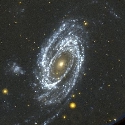 |
 |
 |
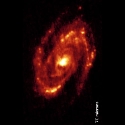 |
Galaxies show a vast range of forms, and faced with any such situation we would like to seek any underlying patterns. This allows a compact description of individual objects, and if we are fortunate will lead to physical understanding (the prototype system of this kind is the MK stellar classification). Galaxy classification has developed with this aim, from rough description of an image through distinctions among components with different astrophysical properties.
It is important to keep in mind that existing schemes are based on the appearance of a galaxy at optical wavelengths (usually in blue light), over the range of surface brightness conveniently recordable from the Earth's surface. As such, these classifications are dominated by certain components of galaxies. There are crude hand-waving arguments implying that any outer faint structure might not be fundamental dynamically - based on lack of star formation there and the small number of crossing times at such distances - but we certainly need to check, and in fact very deep imaging has shown some surprising structures. The original definition of classification criteria in blue light also has implications for use on galaxies at substantial redshifts, where we typically view in the emitted ultraviolet. Recent surveys in the UV and near-IR have led to the notion of a "morphological K-correction", a shift in stage of the morphological classification due to changes in observed wavelength. This becomes especially important if we want to compare populations of galaxies at very different redshifts, so that different sets of galaxies are seen at different emitted wavelengths. As a specific example of how galaxies can change in appearance, here is a multiwavelength series of images of M81 = NGC 3031. Some of the same effects can be seen by comparing (observed) optical and near-infrared structures of faint galaxies, such as this example from WFPC2 and NICMOS imaging in the Hubble Deep Field.
 |
 |
 |
 |
 |
These are, left to right: a ROSAT image, from data archived at HEASARC; a color-mapped UV image from GALEX; an optical color image, from data provided by G. Bothun; a near-IR image from the 2MASS atlas [Atlas Image obtained as part of the Two Micron All Sky Survey (2MASS), a joint project of the University of Massachusetts and the Infrared Processing and Analysis Center/California Institute of Technology, funded by NASA and the NSF], and a 70-μ image from Spitzer.
Comparing these images, starlight from the general population is important from the UV to the near-IR. Only recent star formation is important in the mid-UV, with the bulge vanishing. A more subtle shift occurs between optical and near-IR. Much of the bulge light can now be associated with a broad barlike oval distortion, and the spiral arms are now seen mostly by the light of red giants - not only are they smoother, but the ridge lines of the arms don't quite match those traced by young stars in the opti cal and UV. These young tracers tell where the density wave has driven cloud collapse, which may have a delay from the deepest potential perturbation and may not match the smoothed potential traced by the older stars.
Thought question: What kinds of galaxy classifications would have arisen if we had first encountered galaxies via the UV, or in the near-infrared? How about observing from downtown Rio or the surface of Pluto?
The earliest schemes were purely descriptive, dating to times before galaxies and gaseous nebulae could be distinguished. An example is Wolf's system from 1908, shown in Fig 1 of Sandage in SSS9:

Already sequences of disk systems with changes in inclination were recognized; Curtis used photographs of such systems to study the distribution of absorbing matter in the disks of spirals even before their nature was known.
The first overall scheme (which remains in widespread use) was that of Hubble. This system distinguishes ellipticals, spirals with and without bars, and irregulars. The classification criteria are:
Hubble types can be conveniently arranged in the famous "Tuning Fork" diagram. The schematic example is taken from Realm of the Nebulae, as reprinted by Sandage 1975.
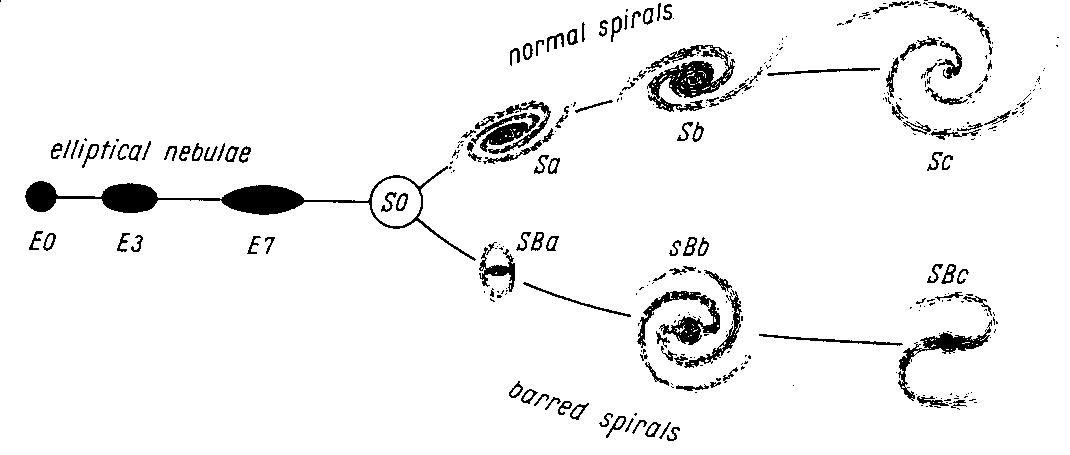
Ray White has posted a tuning-fork diagram using DSS images. Here is a version including some additional deeper CCD data I had lying around:

and one uising images from the Hubble telecope itself:
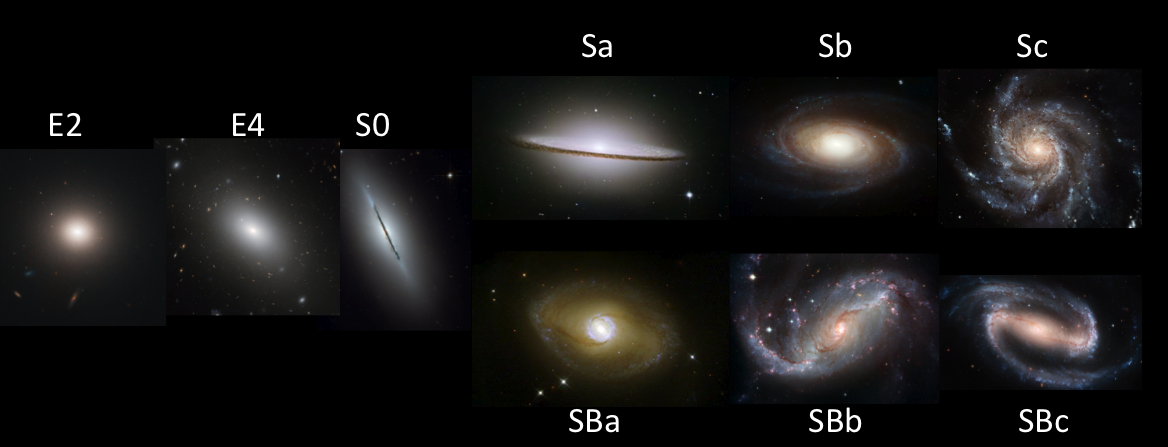
The "definitive" version of the Hubble classification was set out in Sandage's article in Galaxies and the Universe. Compared to Hubble's original conception, this version adds the S0 (lenticular) class between ellipticals and spirals. Hubble hypothesized such an intermediate class, but it was only recognized later. Galaxies are often called early (E and S0) or late (Sb,Sc, Irr) in type, a remnant of early notions that galaxies physically evolve along the Hubble sequence. Unfortunately, this nomenclature is opposite to that of the dominant stellar population in these types, and to the early-late nomenclature in the Yerkes classification.
Classification of an elliptical galaxy image is straightforward, because there is so little structure present. Types E0-E7 are recognized, where the number gives the projected axial ratio. Specifically, an E0 galaxy appears circular (like M87), and in general for axial ratio b/a the number is 10(1-b/a). True ellipticals do not appear more flattened than E7, probably because there is a stability limit for nonrotating systems near this shape. Note that even the ellipticity is not completely well-defined, as many ellipticals have changes in ellipticity with radius or isophotal twists. Most appear to be triaxial systems.
Spirals are divided into ordinary (S) and barred (SB) families, with a stage from S(B)a ("early" types, large bulge, tightly wound and fairly smooth arms) to S(B)c ("late" spiral, small bulge, loosely would arms, arms very textured with star-forming regions). As noted in the Hubble atlas, some spirals have arms patterns defined more by the dust lanes than by starlight per se. NGC 253 is a prominent example. For much of its extent, I find the foreground galaxy in NGC 3314 to be a personal favorite of this kind.
This classification has gained such currency because (1) it is simple and thus accomodates the great majority of bright galaxies and (2) it is our great fortune that it correlates well with astrophysical quantities like bulge/disk ratio, gas content, star-forming properties, spectrum, chemical composition of ISM, etc. This is especially nice since the classification was originally designed solely to describe galaxies' appearance on photographs! Several refinements toward a continuous sequence have been made. Sandage not only explicitly recognized transition S0 galaxies, but found subtypes depending on the amount of dust in the disk plane (and strength of the disk) denoted S0-, S0,S0+ as in the Hubble Atlas. S0 systems pose some interesting problems of recognition when not seen close to edge-on, since they are tough to tell from ellipticals with extended envelopes.
de Vaucouleurs introduced several important features:
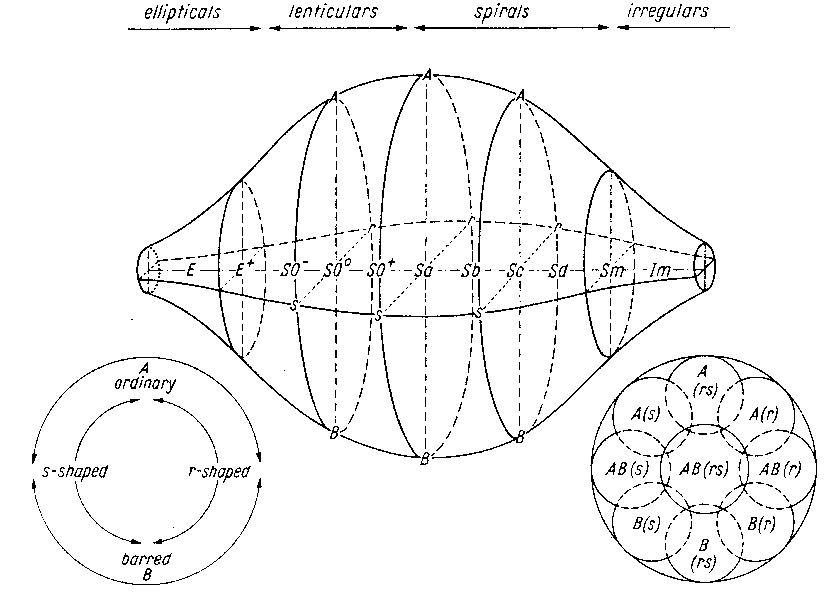
The artist's conception below shows how the SA/SB and r/s classes interact at stage Sb (from Fig.1 of the RC1, likewise scanned in Combes and Buta (1996) and reposted courtesy of Ron Buta). A typical classification in the de Vaucouleurs system looks like SAB(rs)bc (in fact, this is the alleged type of our own galaxy).

van den Bergh recognized an additional family of smooth-armed ("anemic") spirals, considering now that there exist parallel sequences S0,A,S. Thus the tuning fork becomes a trident (see Fig. 5-8 of Mihalas and Binney). These are most common in pretty rich clusters, but don't seem to be numerous for later Hubble types (small bulge:disk ratios), and the question immediately presents itself as to whether anemic spirals are waypoints between "normal" spirals and S0 systems.
He has also introduced the luminosity class, ranging from I-V, which is based on the degree of order in the spiral pattern. Sc I galaxies have very long organized arms, Sc Vs have very poorly organized patterns. These classes do correlate with absolute magnitude, although not as tightly as first hoped. One still occasionally reads of Sc I spirals as the brightest such objects, used as rough standard candles. Even with the luminosity class from arm structure, the appearance of a spiral is not a reliable guide to its linear size (something that David Block stressed years ago in an atlas published at Fort Hare, South Africa). Pretty similar-looking spirals can often differ in size by a factor 5 - M81 is a pretty small spiral compared to some of the ones in Virgo, and NGC 309, UGC 2885, NGC 3312, and NGC 6872 are huge (the largest extending to observed diameters more than 250 kpc for H0=50). van den Bergh has described many classification issues, morphological and quantitative, in Galaxy Morphology and Classification (Cambridge, 1998).
The Yerkes (or Morgan) scheme uses strictly the relative prominence of disk and bulge (the Hubble classification includes arm structure) - these are generally correlated, but not uniquely. This classification uses a form factor E,S,B, or D (for symmetric but non-E or S systems) and inclination class 1-7 (7 most elongated) plus a spectroscopic type corresponding to the nearest stellar equivalent to the spectroscopic appearance of a typical galaxy of similar morphological structure (confused yet?). This ranges from a-k, so Yerkes types look like Egk1, Iaf3, Sfg7, Bg4. The spectroscopic class is based on visual inspection of the image even though it looks like a spectral type. The system was defined and illustrated in PASP 70,364 (1958), ApJ 135,1 (1962), ApJ 142, 1364 (1965), and AJ 76,1000. The types most used from this system are some of the outliers: N-galaxies whose light is dominated by an unresolved nucleus, and cD galaxies for supergiant (spectroscopic nomenclature c) galaxies with extended envelopes. As noted in van den Bergh's book, the concentration changes little over the Hubble type range E-S0-Sa, and changes a great deal within the Sc class, graphically demonstrating that physical properties for any kind of purely morphological classification may have a highly nonlinear mapping to that classification's criteria, even when we are fortunate enough for there to be a useful mapping at all. Classifications of this kind, based on light concentration, have received renewed interest in the context of high-redshift galaxies, and with the recognition that they can be made robust even for poorly resolved systems by appropriate modelling.
Vorontsov-Velyaminov produced a purely descriptive scheme that incorporates peculiarities such as three-armed spirals and gamma-forms. This accomodates most of the oddballs that the Hubble scheme doesn't, but does not yet allow a continuous sequence. It was illustrated in vol. 1 of the MCG. This points up various attitudes toward galaxies that don't really fit in systems like the Hubble classification - is it right to force them into one of the bins? How peculiar is peculiar? As transient phenomena, should interaction-induced distortions be dignified with a place in the scheme et all? (De Vaucouleurs wrote several times that we don't have a special model name for the prodicts of an automotiove collision. But then cars aren't self-gravitating systems).
Spiral structure has been divided into grand-design and flocculent types, depending on the level of organization. The Elmegreens (1982 MNRAS 201, 1021; 1987, ApJ 314, 3) use an index that distinguished these, still on a purely visual level. The arm class ranges from 1 ("chaotic, fragmented, unsymmetric spiral arms") to 12 ("two long symmetric arms dominating the optical disk") Such distinctions have been long noted (for example in the Hubble Atlas and in part in van den Bergh's luminosity classes), but interest in disk dynamics eventually provoked a separate numerical estimate of arm organization.
Some galaxies fall outside the commonly recognized sequences. Many of these are "train wrecks", transient forms produced by the interaction or merger of galaxies. These forms include ring (not ringed) galaxies, polar rings, shells, and systems with tails, as well as double nuclei and highly asymmetric galaxies. Possibly related are what Hubble called Irr II and de Vaucouleurs calls I0 systems. The type example is M82; a galaxy with early-type stellar spectrum, but no particular spiral structure and amorphous appearance. These are almost always found in dense environments and appear to result from interaction-induced bursts of star formation.
There have been numerous papers purporting to give a ``true" physical explanation for the Hubble sequence. Their authors are, to my mind, missing the point. Classification must begin as a descriptive process; the desired physical insight is a rather different thing.
Basic references on classification: for the Hubble system, see the Hubble Atlas, Revised Shapley Ames Catalog, Sandage-Bedke NASA atlas, and Carnegie Atlas of Galaxies. Luminosity classification of spirals was described by van den Bergh in ApJ 131, 215 (1960) and ApJ 131, 558 (1960); the NASA atlas includes many examples. de Vaucouleurs (1977, Yale conference p. 43) discusses comparison of classification with quantitative parameters. Dwarf galaxies were not included in these original schemes; see Sandage and Binggeli 1984 (AJ 89, 919). Many useful references are given in van den Bergh's review (JRAS Canada 69, 57, 1975) and in Sandage, SSS vol 9. Dwarfs can be classified based on whether a distinct nucleus is present and on whether the structure is spheroidal or more irregular. Some fall in the low-surface-brightness (LSB) category, though this also includes very large and massive systems; our understanding of LSB galaxies and how they relate to other kinds is still in its infancy.
Classification on these systems is fairly robust; experienced observers generally agree on a galaxy's Hubble type to a level DT = 0.7 on the scale where the range from, say, Sa to Sab is one unit (and automated systems can be trained to a similar level). So what is this system "telling" us? The Hubble type (or T) can be shown to correlate with:
We may usefully consider many galaxies as composed of some "building blocks" whose scale and importance varies from galaxy to galaxy. These include a nucleus, bulge, lens, bar, spheroidal component, disk (with arms, rings,...), and an unseen halo which is significant for the mass distribution and dynamics. The order revealed by existing classification systems tells us that these are not really independent; disk/bulge correlates overall with arm morphology, for example. These relations hold clues to both the formation and evolution of galaxies (unfortunately not easy to tell which is which). Many simulations suggest that bar and ring structure may evolve; we would like to distinguish properties which are primordial, or at least permanent once acquired, from those that are temporary.
There has been very interesting recent work on automated classification of galaxy images, and on classification from minimal information (that is, from poorly resolved images as we get at high redshift). A few brave souls have tackled the automated recognition of "peculiar" galaxies, which would be a prerequisite for thinking we understand how their abundance might change with redshift and environment. Most people who have worked with deep HST images have been impressed by how peculiar faint galaxies are as a class, and it's a key question how much of this is a real difference from the local Universe and how much arises from color and surface-brightness selection effects which favor detection not only of galaxies which are forming stars at the relevant epoch, but of those pieces of galaxies that are doing so.
One approach to automated classification is to ask what set of analytic or empirical components (bulge, disk) best represent a galaxy's detected image, and what the expected errors (say in the χ2 sense) are. The limitation here is that even in perfectly ordinary galaxies, the fitted forms for these components vary, and many galaxies have images that overlap with neighbors or are dotted with brilliant star-forming regions. A quite different approach is taken by neural-network schemes. Here, one defines a set of input values based on the galaxy image, and trains the code using a large set of galaxies classified by eyeball (usually by several sets of eyeballs for a consistency check). The code then finds the set of hidden connections needed to give these outputs, and can apply this mapping to any further data desired. This is thought to be an analog of what the human brain does in learning to recognize patterns, though working backwards, it is not particularly clear just what the code is responding to in the image, except that it looks most like the typical image that it was taught to classify in this way. Neural net classifiers seem to be statistically about as good as human ones, which is especially impressive if one considers that people may fold in all sorts of outside knowledge as to redshifts and passbands in their estimates. A detailed comparison of human and neural classifiers was presented by Naim et al. 1995 (MNRAS 274, 1107).
The drive to derive as much information as possible from the expensive images of distant galaxies has led to the use of very simple image moments to classify galaxies. The idea is much like that of the Yerkes classification - the light is more concentrated in earlier-type galaxies. One implementation, by Fukugita et al. (1995 ApJ 439, 584) used HST imagery as "ground truth", and ground-based images in mediocre seeing to classify. Knowledge of the PSF is crucial, since this enters into the mapping between true and observed concentration indices in their (concentration, mean surface brightness) diagram. Results which are valid even in a statistical sense are useful in mapping the content of galaxy clusters, or using survey data to cover large areas of the sky at low resolution. A similar scheme, but designed to augment the Hubble system, was described by Abraham et al. (1994, ApJ, 432, 75). These automated classifications are by and large outgrowths of a long-standing broader classification problem - separating star and galaxy images at the faintest limits. Conselice and colleagures have made extensive use of a simple system involving concentration, asymmetry, and smoothness (CAS) parameters. Concentration C is measured as (for example) the logarithmic ratio of the radii containing 90% and 50% of the light. Asymmetry uses the fact that an arbitrary function can be decomposed into even and odd parts, and the figure derived is the absolute value of the departures from symmetry. The S parameter is more complex and data-dependent to derive; it describes the fraction of light in a galaxy image contained in bright structures smaller than a set threshold scale. Very crudely, C maps to morphological stage, A to interaction histroy, and S to star-formation rate, but these mappings are broad enough that the most powerful use of CAS is in comparing galaxy samples against each other.
Another frontier in classification problems is how we should classify galaxies in the UV or infrared. Only now are large enough samples (such as the IR galaxy atlas derived from 2MASS data by Jarrett) being observed to tackle such problems systematically, and preferably without direct reference to the optical properties. The UV issue long relied largely on UIT imagery, with some HST snapshots being done for more distant galaxies to augment the very limited data on nearby galaxies. This situation is being systematically improved with the nearly all-sky GALEX survey. It has already turned up not only the expected sensitive tracers of star formation in early-type galaxies, but a category of spirals with very blue, low-surface-brightness outer disks which must have an interesting history of star formation.
Going against the grain of this trend to simplify classification in the interest of automation, the Galaxy Zoo project has employed the contributions of hundreds of thousands of volunteers to derive increasingly sophisticated visual classifications for nearly a million galaxies in the SDSS, turning up some surprises (blue ellipticals, red spirals, different growth histories for black holes in galaxies with and without disks...) I think this has been an excellent idea!
Last changes: 1/2015 © 2000-15